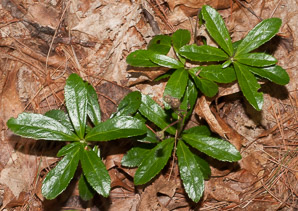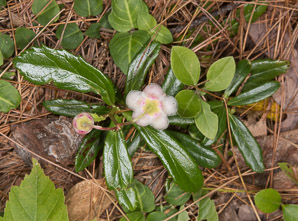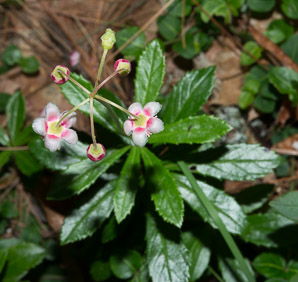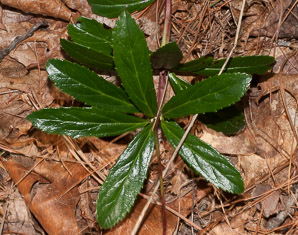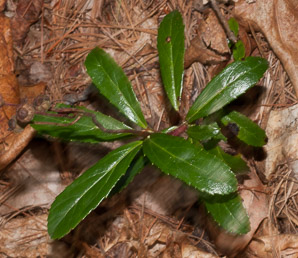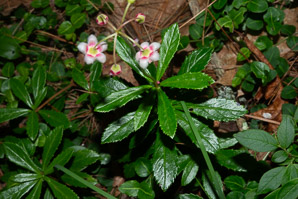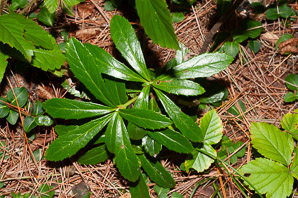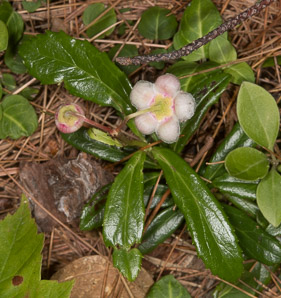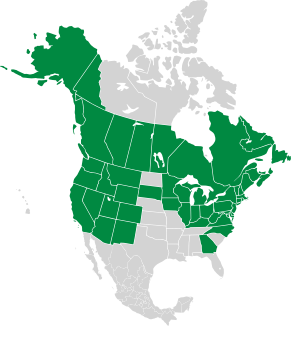
|
Chimaphila umbellata (L.) W.P.C. Barton Common pipsissewa, noble prince’s-pine
Pipsissewa is a low flowering evergreen plant native to the cooler parts of the Northern Hemisphere. Like many forest floor plants that have to make do with limited light, they complement energy from photosynthesis with that from another source, in this case from soil fungi. They are myco-heterotrophs—they parasitize the fungi. They are common in coniferous or mixed forests, with acid, thin, sandy soils. Plants: 4-14″ (10-35 cm) tall, with an umbel of flowering stalks above. Leaves: Leaves are shiny, toothed, and wider toward the far ends. They are arranged in a whorl, or in opposite pairs, around the stem. Flowers: White or pink, in groups of two to eight. The flowers hang downward, and are ½-¾″ (1.3-1.9 cm) around. Each flower has five petals that are pink at first, turning white, but remaining pink at the base. It has ten stamens. Fruits: Upright capsules ⅛-3/16″ (4-6 mm) around, with five sections. They are reddish brown, drying to a dark brown and remaining through the winter. They split open to release seeds. Edibility: Leaves can be used as tea or a flavoring for root beer. Medical: Pipsissewa has a number of unproven uses for kidney and bladder problems, cystitis and edema, and regulation of menstrual cycles. Although plants are not toxic unless used for a long period, neither do they have any confirmed medical uses. Online References:
References:
Multiple Authors, PDR for Herbal Medicines, Thomson Healthcare Inc., 2007, p. 654 8/23/2012 · Nashua River Rail Trail, Groton, Groton, Massachusetts · ≈ 12 × 8″ (31 × 20 cm) 7/2/2017 · Wildlife Pond, Beaver Brook Conservation Area, Hollis, New Hampshire · ≈ 5 × 8″ (13 × 20 cm)
Chimaphila umbellata description by Thomas H. Kent, last updated 28 Dec 2020. © FloraFinder.org. All rights reserved. |
7/3/2015 · Squannacook River Wildlife Area, Townsend, Massachusetts · ≈ 8 × 5″ (19 × 13 cm) 8/23/2012 · Nashua River Rail Trail, Groton, Groton, Massachusetts · ≈ 11 × 7″ (27 × 18 cm) 8/23/2012 · Nashua River Rail Trail, Groton, Groton, Massachusetts · ≈ 11 × 7″ (27 × 18 cm) 7/3/2015 · Squannacook River Wildlife Area, Townsend, Massachusetts · ≈ 9 × 6″ (23 × 16 cm) 9/24/2010 · Nissitissit River Wildlife Management Area, Pepperell, Massachusetts · ≈ 9 × 6″ (23 × 15 cm) 7/2/2017 · Wildlife Pond, Beaver Brook Conservation Area, Hollis, New Hampshire · ≈ 7 × 4½″ (18 × 12 cm) Range:
|
